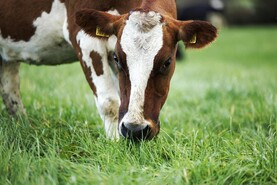It’s well known that farmers are not always the best patients after an injury. None more so than myself after I managed to tear ligaments in my ankle a fortnight ago, meaning I’ve been confined to very little walking around the farm.
Thankfully, I have the quad to move about on outside, so I’m not cooped up in the house completely.
While it’s slowly on the mend, I’m sure my father is continuing to wonder if I’d be better off using a bluestone wash on it daily, instead of the gel I’ve been prescribed.
More Pepper! And his Mammy Maxy in the background watching ?? pic.twitter.com/fskUjsEYPD
— Karen McCabe (@LadyHaywire) October 11, 2021
I’ve also been kept distracted with planning ideas for a school class I’ve been paired with in ‘FarmerTime’.
This is a scheme where a farmer liaises with a primary or secondary school class and engages in a fortnightly video call with them. It’s an excellent way to bring the excitement and interest of farming into the classroom and allows the kids to speak one on one with an active farmer and learn firsthand how things are done.
Traditional habit
With our small herd and our traditional habit of giving each animal a nickname, I got paired with a delightful class of junior infants and they will certainly keep me on my toes with all the questions they’re dreaming up.
It's wet this morning so this is the perfect time for indoor work.
— Karen McCabe (@LadyHaywire) October 6, 2021
Getting ready for my first #Farmertime Zoom call on Friday ??
Exciting! pic.twitter.com/VA3d8n1B20
With a surplus of heifer calves this year, we have chosen four from our better breeding lines to keep on as replacements, removing one cow which isn’t producing calves to a standard we aim for, along with a couple who are just too temperamental at calving time to justify keeping them for another year.
Moving forwards, we’re trying to make things safer and easier on the farm, and removing the ones which just aren’t up to scratch is the logical first step.
With those three gone, it should make our grazing period last a bit longer and, as they are some of the heavier cows we have, it should ease the impact on ground conditions also.
In keeping with our usual grass management at this time of year, we split the cows into three different groups, based on the calves' ages, with creep feeders in place for the two older groups. With our small fields, this works best, as it means there’s not 25 cattle trudging around in the one area.
Moving some stubborn cows earlier. Have a cameraman today ?? pic.twitter.com/10SfOboLfj
— Karen McCabe (@LadyHaywire) September 26, 2021
In comparison to last year we’re doing very well, as, in 2020, we had over half the cattle housed at this stage. Of course, sod’s law dictates that the temperamental cows we’re removing are excellent breeders.
When we did our annual weighing for the BEEP-S Scheme, one of their calves weighed 460kg at eight months of age, with the other being 250kg at just four months.
Weighed all the cows and calves yesterday. Snoopy here is 460kg.Thats some going for a calf born at the end of January! pic.twitter.com/e0aVzunh6i
— Karen McCabe (@LadyHaywire) September 22, 2021
We sold the heavier bull in Carrigallen the day after weighing and it wasn’t until I was in the mart looking at stock and assessing the trade that I realised just how much I’d missed the days out there. There’s always banter to be found around the yard and it was a welcome relief to meet and speak to people I hadn’t seen in almost two years.
While watching sales on the laptop is a simple way to pass time and get an idea of the trade, there’s nothing like chatting to people over tea and chips and eyeing up animals you wouldn’t mind taking home.






 This is a subscriber-only article
This is a subscriber-only article











SHARING OPTIONS: